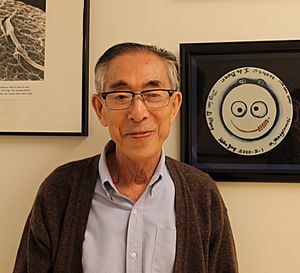Ryuzo Yanagimachi facts for kids
Quick facts for kids
Ryuzo Yanagimachi
|
|
|---|---|

Yanagimachi in 2014
|
|
| Born | August 27, 1928 Ebetsu, Hokkaido, Japan
|
| Died | September 27, 2023 (aged 95) |
| Alma mater | Hokkaido University |
| Scientific career | |
| Institutions | Worcester Foundation for Biomedical Research John A. Burns School of Medicine University of Hawaiʻi at Mānoa |
Ryuzo Yanagimachi (柳町 隆造, Yanagimachi Ryūzō, August 27, 1928 – September 27, 2023) was a Japanese-born scientist who lived and worked in America. He made many important discoveries about how mammals reproduce. He was also a leader in the field of cloning, which means making an exact copy of an animal or plant. In 1997, his lab at the University of Hawaiʻi at Mānoa successfully cloned mice. They used a special method called the "Honolulu technique."
Contents
About Ryuzo Yanagimachi
Yanagimachi was born in Ebetsu, Japan, and grew up in Sapporo. He studied zoology (the study of animals) and embryology (the study of how living things develop before birth) at Hokkaido University. He earned his first degree in 1952 and his science doctorate in 1960. At first, he couldn't find a research job, so he taught high school for two years.
Later, Yanagimachi applied for a special research position with Dr. M. C. Chang. This was at the Worcester Foundation for Biomedical Research in Massachusetts. He got the job and there he figured out how to fertilize hamster eggs in vitro. This means fertilizing them outside the body, in a lab dish. His work helped lead to in vitro fertilization (IVF) for humans and other mammals. IVF is a way to help people have babies.
In 1966, Yanagimachi moved to the University of Hawaiʻi. He became a professor in the Department of Anatomy and Reproductive Biology. He worked there for 38 years. In 2005, he retired but kept working with younger scientists. He was married to Hiroko, who used to be a child psychologist. She couldn't find work in her field in the U.S. because of the language. So, she became an electron microscopist in his lab, using a special microscope to see tiny things.
Ryuzo Yanagimachi passed away on September 27, 2023. He was 95 years old.
Cloning Mice: The Honolulu Technique
In July 1998, Yanagimachi's team shared their amazing work on cloning mice. They published their findings in a famous science magazine called Nature. Yanagimachi named their new cloning method the "Honolulu technique."
The very first mouse they cloned was named Cumulina. Her name came from the "cumulus cells" that were used to clone her. When their research was published, they had already made over 50 cloned mice. These mice even had three generations of offspring! An international team of scientists helped with this work. Some of the co-authors included Teruhiko Wakayama and Tony Perry.
Because of the success and fame from the Nature article, Yanagimachi's lab moved. It went from an old warehouse to a new building. This new place was called the Institute for Biogenesis Research.
The Yanagimachi lab and his former colleagues kept making progress in cloning. In 1999, they announced they had cloned the first male animal from adult cells. In 2004, they helped clone a male mouse that couldn't have babies naturally. This discovery might help scientists learn more about human infertility.
Mice cloned using the Honolulu technique were shown in museums. You could see them at the Bishop Museum in Honolulu, Hawaiʻi, and the Museum of Science and Industry in Chicago, Illinois.
Early Research and Contributions
Before 1960, when he was a student at Hokkaido University in Japan, Yanagimachi studied fish reproduction. He also researched a type of parasitic barnacle called rhizocephalans.
Throughout his career, he made many important discoveries about how mammals reproduce. He also helped create new ways to assist with fertilization. His detailed review of "Mammalian Fertilization" published in 1994 is considered a classic in the field.
Awards and Honors
Ryuzo Yanagimachi received many awards for his important work:
- Fulbright Scholarship, US-Japan, 1960 and 1964
- Zoological Society Prize, Japan, 1977
- Research Award, Society for Study of Reproduction, US, 1982
- University of Hawaii Regents' Medal for Excellence in Research, US, 1988
- Marshall Medal, Society for the Study of Fertility, UK, 1994
- International Prize for Biology, Japan, 1996
- Honorable Degree of Philosophy from the University of Rome, Italy, 1997
- Distinguished Andrologist Award, American Society of Andrology, US, 1998
- Induction to the Polish Academy of Sciences, Poland, 1998
- Carl G. Hartman Award, Society for the Study of Reproduction, US, 1999
- Honorary Member, European Society of Human Reproduction and Embryology, 1999
- Pioneer Award, International Embryo Transfer Society, 2000
- Induction to the National Academy of Sciences, US, 2001
- Honorable Degree of Philosophy, Hokkaido University, Japan, 2002
- Induction to Hall of Honor, National Institute of Child Health and Human Development, US, 2003
- Pioneer Award in Reproduction Research, US, 2012
- Lifetime Achievement Award, Society of Reproductive Biologists and Technologists, US, 2014
- Kyoto Prize in Advanced Technology, Japan, 2023
See also
In Spanish: Ryuzo Yanagimachi para niños

